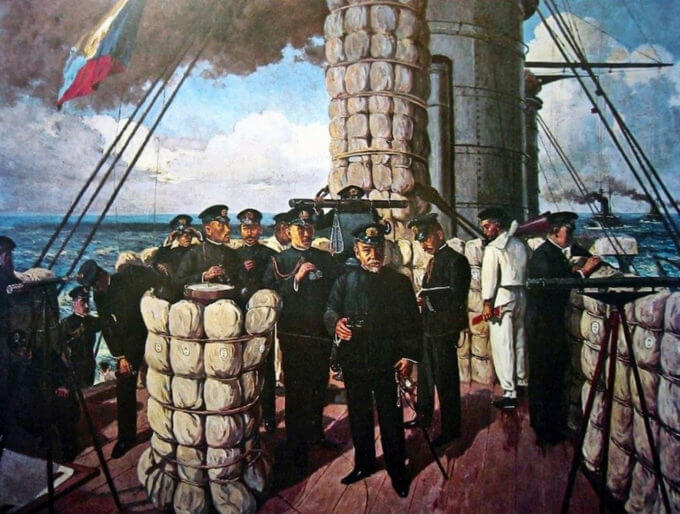
This is a true story of a man who brought a decisive victory in a fleet battle using an amazing psychic power in the Russo-Japanese War.
His name is Akiyama Saneyuki, Japanese Admiral.
Japanese Admiral Akiyama Saneyuki (1868-1918)
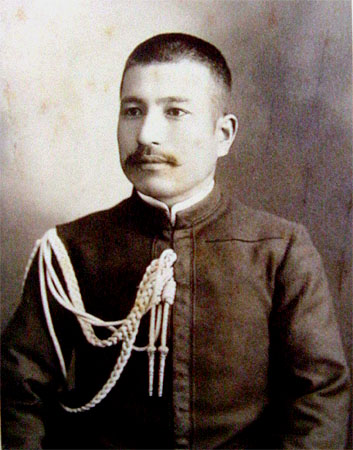
Akiyama was a planning staff of Togo Heihachiro, a Japanese Commander in Chief of the Combined Fleet of Imperial Japanese Navy.
He played a central role for planning for the naval battles through the Russo-Japanese War (1904−1905).
Amazingly, Akiyama was “Psychic Admiral” who brought a decisive victory with a psychic power.
The anecdote about Akiyama’s psychic power is known to Japanese spiritual researchers, but it is not very well known outside Japan.
So, I would like to introduce Akiyama’s amazing psychic power in a fleet battle fought between Japan and Russia.
Admiral Tōgō, “The Nelson of the East”
In May 27-28, 1905, the Battle of Tshushima was fought between Russia and Japan during the Russo-Japanese War.
It was only decisive sea battle fought by modern steel battleship fleets in naval history.
At that time, Russia was the world’s third largest naval power.
The Imperial Russian Navy was formally established in 1696.
On the other hand, the Imperial Japanese Navy (IJN) was formally established in 1868, about 170 years after the establishment of Imperial Russian Navy.
However, in the Battle of Tsushima, the Japanese fleet under Admiral Tōgō Heihachirō destroyed all the battleships and most of the cruisers and destroyers of the Russian fleet.
Marshal-Admiral The Marquis Tōgō Heihachirō (1848 – 1934) of the Imperial Japanese Navy. Tōgō was termed by Western journalists as “the Nelson of the East”.
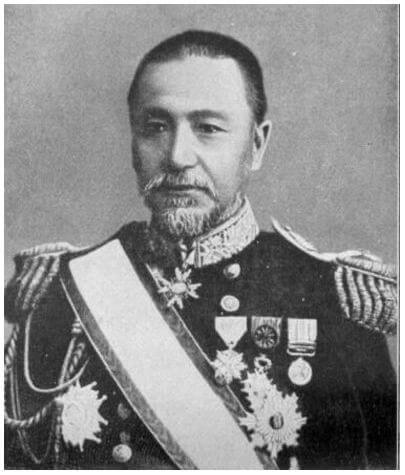
As Commander-in-Chief of the Combined Fleet of the Imperial Japanese Navy, Tōgō won a decisive victory over the Russian fleet.
This battle broke Russian naval dominance in East Asia, and is said to have been a contributing factor in subsequent uprisings in the Russian Navy (1905 uprisings in Vladivostok and the Battleship Potemkin uprising), contributing to the Russian Revolution of 1905.
The battle effectively ended the Russo-Japanese War in Japan’s favor.
Later, Sir George Sydenham Clarke, a British officer and colonial administrator at that time, wrote,
The battle of Tsu-shima is by far the greatest and the most important naval event since Trafalgar.
George Sydenham Clarke (1848-1933)
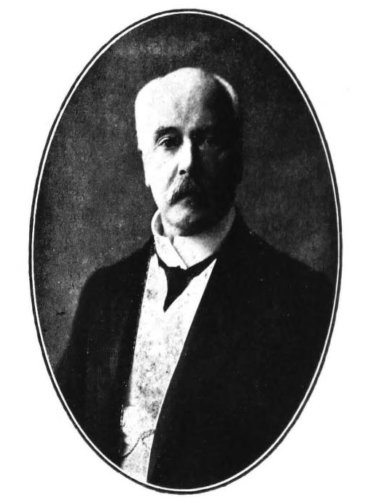
However, in the Battle of Tsushima, the psychic power of Akiyama Saneyuki played an important role.
Akiyama Saneyuki, “Psychic Admiral”
On February, 1904, at the start of the Russo-Japanese War, the bulk of the Russian Pacific Fleet was blockaded within the confines of Port Arthur by the Imperial Japanese Navy.
Battlefields in the Russo-Japanese War
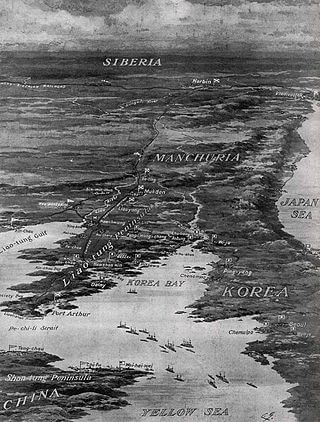
However, the Russian subsidiary naval base at Vladivostok remained largely undamaged.
Located at Vladivostok was a garrison force consisting of the light cruiser Bogatyr and auxiliary cruiser Lena and a stronger Vladivostok Independent Cruiser Squadron consisting of the armored cruisers Rossia, Rurik, and Gromoboi.
On the other hand, the Imperial General Headquarters ordered Admiral, Baron Kamimura Hikonojō to contain the Russian cruiser squadron based in Vladivostok.
Admiral Baron Kamimura Hikonojō
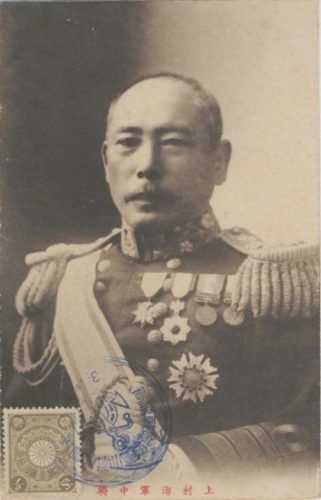
It is because that the Japanese fleet under Admiral Tōgō (the IJN 1st Fleet) continued to blockade Port Arthur in hopes of luring the battleships of the Russian Pacific Fleet into an open sea.
However, heavy fog often covered in the Sea of Japan, giving the Russians an advantage in their commerce raiding operations.
The Russian cruiser squadron appeared suddenly and attacked on Japanese troopships in the Sea of Japan, but the Japanese 2nd fleet could not close with the Russian squadron.
Under these circumstances, Akiyama awoke his psychic power.
The First Prophetic Dream
At that time, Akiyama thought through every day and night the possible route of the Russian squadron, because the Russian squadron had two main routes for their commerce raiding operations.
The first was the route that the Russian squadron heads east in the Sea of Japan to pass through the Tsugaru Strait.
The second was the route that the Russian squadron heads south in the Sea of Japan to pass through Tsushima Strait.
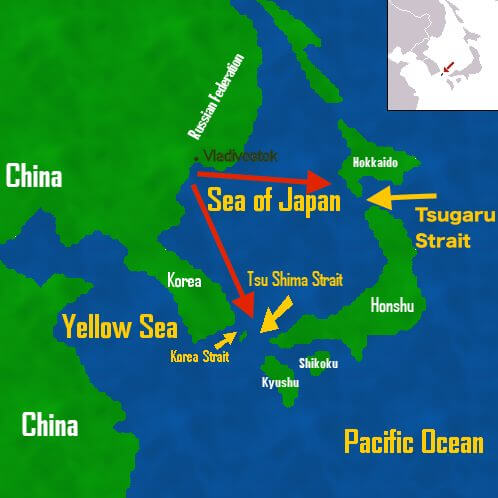
One day, Akiyama worried about the possible route of the Russian squadron through the night, but he fell into a doze from exhaustion.
Suddenly, a strange vision appeared before his eyes.
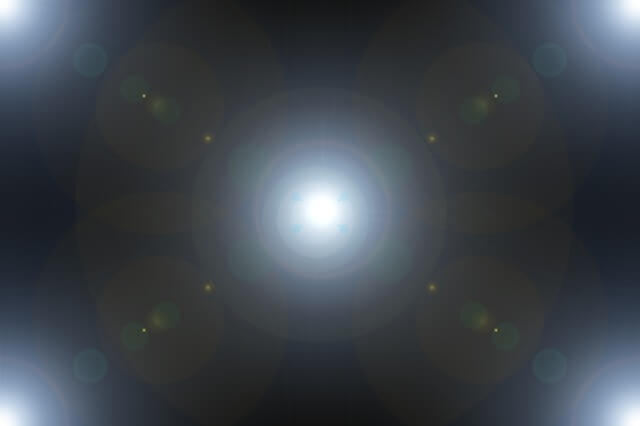
The vision spread out getting lighter, even though both eyes were closed.
Amazingly, the vision turned into a full view of the east coast of Japan.
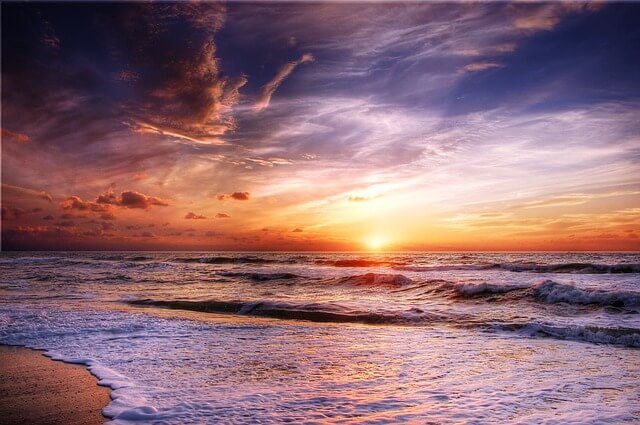
Oh! What’s that?
I wonder if I’m dreaming?
Akiyama stared the vision with amazement.
He noticed the three small black dots heading north through the blue sea of the Tsugaru Strait.
He recognized that those three dots were Russian cruisers, Rossia, Rurik, and Gromboi.
Akiyama tried to imprint the scenery, but suddenly he woke up from a strange dream.
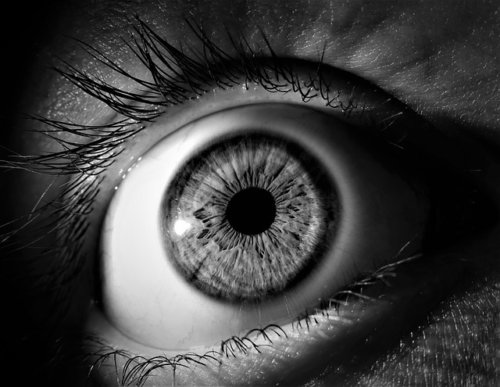
What on earth was that?
Was I dreaming?
After this strange experience, Akiyama reported to the Naval General Staff Office based on his dream.
It is expected that Russian fleet would pass through the Tsugaru Strait.
Therefore, I would propose that the 2nd fleet should intercept the enemy at the Tsugaru Strait.
The Naval General Staff Office did not adopt his proposal and sent the 2nd fleet to the Pacific.
Akiyama was discouraged to learn that his proposal had been rejected.
However, the Russian fleet passed through the Tsugaru Strait, just like Akiyama saw in the strange dream.
As a result, the 2nd fleet failed to catch the Russian fleet.
That was a prophetic dream to tell me the route of the Russian fleet!
My dream came true!
In this way, Akiyama was convinced that he had a psychic power to foretell the future.
The Second Prophetic Dream
About one year later, Akiyama saw the future in his dream again.
On October 15-16, 1904, the Russia sent the Second Pacific Squadron from the Baltic ports of Reval and Libau to overwhelm the Imperial Japanese Navy.
The Second Pacific Squadron sailed through the Baltic into the North Sea.
Route taken by the Russian Second Pacific Squadron (in blue) from the Baltic to the Battle of Tsushima.
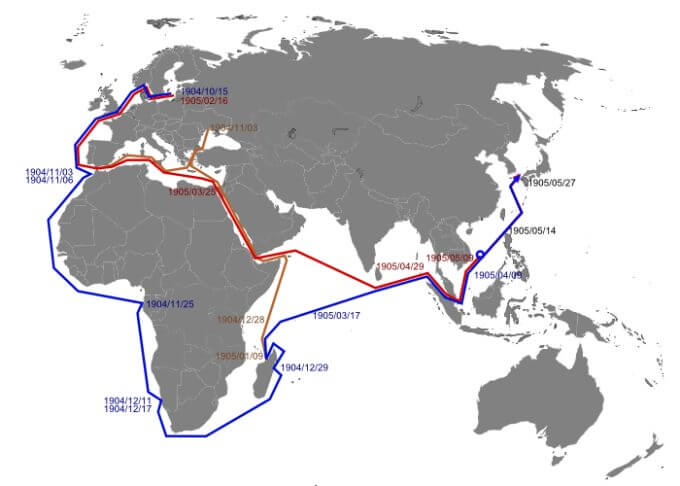
Source – self-made Ref.(Futabasya NihonkaiKaisen ISBN 4-575-47639-0)
The Russians could have sailed through any one of three possible straits to enter the Sea of Japan and reach Vladivostok, that is, La Pérouse, Tsugaru, and Tsushima.
There is one thing that bothered the Imperial Japanese Navy.
Where should they capture and intercept the Baltic Feet?
Thus, Admiral Tōgō gathered captains of all ships in the meeting room of the flagship Mikasa to discuss the possible route of the Baltic Fleet.
Mikasa is a pre-dreadnought battleship built for the Imperial Japanese Navy.

This time, Admiral Tōgō had a good opinion of Akiyama, because Akiyama once had predicted precisely the route of the Russian squadron.
To live up to Tōgō’s expectations, Akiyama tried to shape a plan night and day.
But he was exhausted under pressure.
Late on the night of May 24, 1905, Akiyama threw himself down into an armchair in the cabin and he slipped off to sleep.
Suddenly, a bright light appeared on the back of his eyelids.

The light turned into the deep, boundless expanse of sea.
The billowy ocean burst on him.
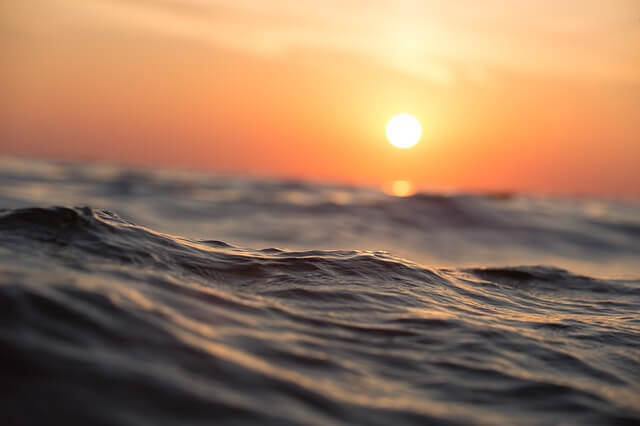
Akiyama recognized that it was the Tsushima Strait.
Is this a prophetic dream?
Where’s the Russian fleet?
Suddenly, he found the Baltic Fleet.
The Russian fleet was coming at him.
He confirmed that the Baltic fleet was formed by two lines and the number of the ships was 38.
Suddenly, Akiyama came back to reality.

Soon after he woke up, he immediately fell to work.
He planned a strategy based on the prophetic dream.
At that time, Akiyama soon found that there was a problem.
If he reports the truth to the Togo’s headquarters that he had saw the route of the Baltic Fleet in the dream, he would meet with ridicule and his proposed plan would be rejected again.
As a result, the Imperial Japanese Navy would fail to spot the Baltic Fleet and lose a battle.
It would be the same mistake as before.
Such a mistake must be avoided at all costs.
Thus, this time, Akiyama analyzed the route of the Baltic Fleet that he saw in the prophetic dream.
Then, he made up plausible explanations based on facts such as geographical conditions and the position of mines.
Furthermore, Akiyama worked out the seven steps for the total destruction of the Baltic Fleet.
After making these elaborate preparations, Akiyama persuaded Admiral Tōgō and the navy staffs to adopt his plan based on the prophetic dream.
Finally, Admiral Tōgō accepted his proposed plan.
The Battle of Tsushima
At dawn on May 27, Akiyama saw the Baltic Fleet.
The Baltic Fleet really came to the Tsushima Strait.
That dream came true!
At that time, he was confident of victory.
Amazingly, the number and the formation of the Russian fleet were quite the same as he saw in the dream three days before.
Then, Akiyama sent the famous telegram to the Togo’s headquarters.
In response to the warning that enemy ships have been sighted, the Combined Fleet will immediately commence action and attempt to attack and destroy them.
Weather today fine but high waves.
Upon receiving the above telegram, the Combined Fleet was immediately ordered to sortie.
Departure of the Combined (Japanese) Fleet.

Based on the Akiyama’s precise prediction, the Japanese were able to position their fleet so that they would “cross the T” of the Russian Fleet.
On May 27–28, 1905, the Japanese engaged the Russians in the Tsushima Straits.
Admiral Tōgō on the bridge of the battleship Mikasa, at the beginning of the Battle of Tsushima, in 1905. Tōgō in the middle and Akiyama on the left back of Tōgō.

As a result of the battle, the Russian Fleet was virtually annihilated, losing eight battleships, numerous smaller vessels, and more than 5,000 men, while the Japanese lost three torpedo boats and 116 men.
Only three Russian vessels escaped to Vladivostok.
In this way, the Battle of Tsushima ended in a decisive Japanese victory.
Later, Akiyama reported the victory of the Battle of Tsushima as follows:
With the help of the gods, the Combined Fleet fought with the enemy’s 2nd and 3rd Fleet in the Sea of Japan on May 27-28.
Finally, we destroyed them almost completely.
The above phrase, “With the help of the gods” expresses Akiyama’s deepest thanks to God that brought him the prophetic dream for giving Japan victory.
It was the first defeat of a European power by a small Asian nation in the modern era.
There is no doubt that It was nothing less than miraculous, because a prophetic dream turned the tide of war.
Published on April 24, 2018
Updated on April 3, 2019
Written by OTAKUPAPA
References
- Kazuaki Deguchi (September 25, 1978). “Prophecies and affirmations of Nao & Onisaburo Deguchi.”
- Shiba, Ryōtarō (2013). Clouds above the Hill: A historical novel of the Russo-Japanese War
- Akiyama Saneyuki, in Wikipedia.



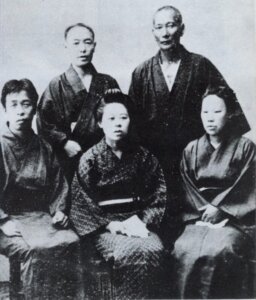


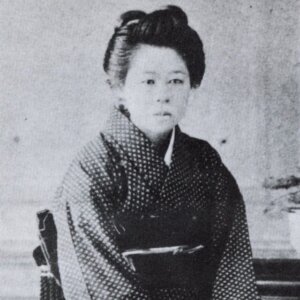
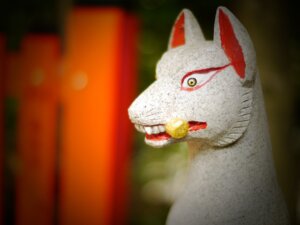
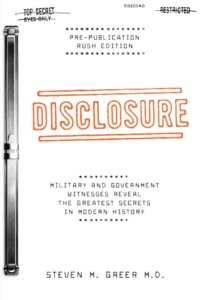
Comments